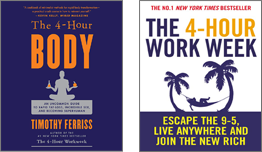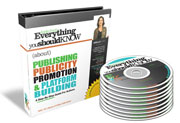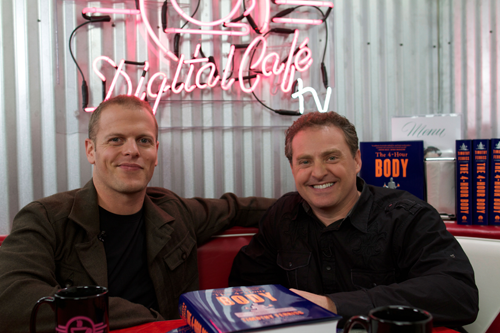Tim Ferriss: On Reinventing Book Marketing

Tim Ferriss is sitting down with Mike Koenigs, one of today’s most successful Internet marketers to discuss his uniquely innovative book marketing strategy—the very same that has just landed Ferriss’ second book, The 4-Hour Body, at #1 on The New York Times bestseller list.
“In the digital world, it’s not just about how many people you can get to buy,” Ferris says, explaining why he has yet to market to the 200,000-name list he has had for the past four years. “It’s about how many people you piss off in the process.”
 That, he adds, is his “fairly rationalized excuse-slash-reason” for defying the #1 rule of online book marketing—cultivating a trusting relationship with your list through regular email marketing.
That, he adds, is his “fairly rationalized excuse-slash-reason” for defying the #1 rule of online book marketing—cultivating a trusting relationship with your list through regular email marketing.
But clearly, Ferriss, who is in the elite group of authors who still receives seven-figure book advances, is on to something. His first book, The 4-Hour Workweek, also claimed the #1 spot on The New York Times bestseller list—for four years running.
 However unconventional, Ferriss’ book launches are also outrageously effective. Having consumed Arielle Ford’s Everything You Should Know course years ago, Ferriss, an innately strategic thinker, lives and breathes the need to grow your online platform and keep your audience engaged.
However unconventional, Ferriss’ book launches are also outrageously effective. Having consumed Arielle Ford’s Everything You Should Know course years ago, Ferriss, an innately strategic thinker, lives and breathes the need to grow your online platform and keep your audience engaged.
For Ferriss, authenticity is critical. “You need to find a platform or a main vehicle that you enjoy using,” he says. “However,” he adds, “intrinsically there are benefits to some longer formats.” While that length may be equally valuable on video as on blogs, when building your audience, volume does matter.
“Your currency online is based on trust and reputation,” he explains. “People trust you when they feel like they know you.” While Twitter can be “very, very helpful,” the reality is, “you don’t get to know someone in 140 characters or less.”
To maintain that trust with your audience, Ferris emphasizes the need to create exceptional products, which, in his case, means writing really good books. One of the few authors at his level who writes all of his own content, he concedes, “you can use PR to get your first round of customers. Past that, your product has to stand on its own.”
If your product, like Ferriss’, is a book, you must get clear on why you are writing it. “Be very honest with yourself,” he advises. “I don’t think it’s bad to recognize that humans are ego-driven, so if you want to be in The Harvard Business Review, that’s one thing. If you want to be in People Magazine, that’s another thing. If you want to be on The New York Times list, that’s yet another thing.”

Once you’ve listed, in numerical order, what you want to accomplish with your book, you need to understand whom you’re writing for. “You will be pressured to write for the biggest audience possible. You need to write this for women… for men… for people in the mid-West… it’s not true.” To write a great non-fiction book, he says, “write for two of your closest friends who have this problem that you have now solved for yourself.”
In addition to being an inspiration for his own book writing, personal relationships are, in fact, the cornerstone of Ferriss’ book launch strategy. Being as clear as he is on his audience—“20 to 35 year-old tech savvy males with disposable income and an interest in hacking”—Ferriss has invested vast amounts of time developing bona fide friendships with the online gatekeepers of his audience.
Before launching The 4-Hour Workweek, Ferriss says, “I basically spent my entire book launch budget” attending tech conferences. “I spent three years getting to know” bloggers at Mashable, Tech Crunch, Gizmodo, and other tech blogs targeted at the audience Ferriss hoped to reach.
However time-intensive, relationship building is a skill Ferriss can’t underscore enough. “You need to develop relationships early,” he begins. Always avoid “picking the people who will be of most utility and then figuring out a way to fake a friendship.” Instead, find the people with whom you share common interests, the “people you would actually be good friends with and hang out and have beers with.” Be yourself, he advises, and “develop a legitimate friendship with them. Hope that at some point they might help you, but don’t expect it.” That last part—about not harboring expectations—“is really important.”
Here’s the thing. “People don’t care how good your idea is. People don’t care how good your book is,” Ferriss explains. “People want to know if they can trust you… they need to trust the messenger before they can even start to listen to the message.”
Admittedly, Ferriss’ ideas are not new. The same relationship building principles that have helped him land at #1 on The New York Times bestseller list twice “worked 2,000 years ago,” he adds.
And with Ferriss as their modern-day advocate, these very principles seem likely to take him, and many others, a long, long way.
